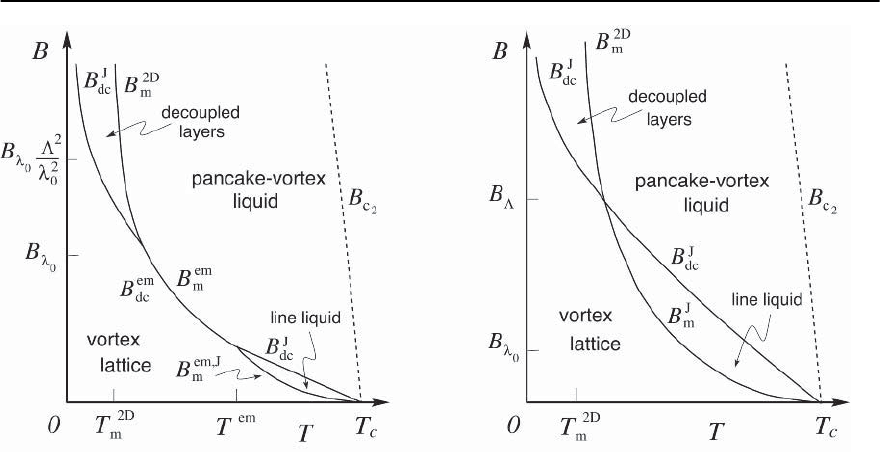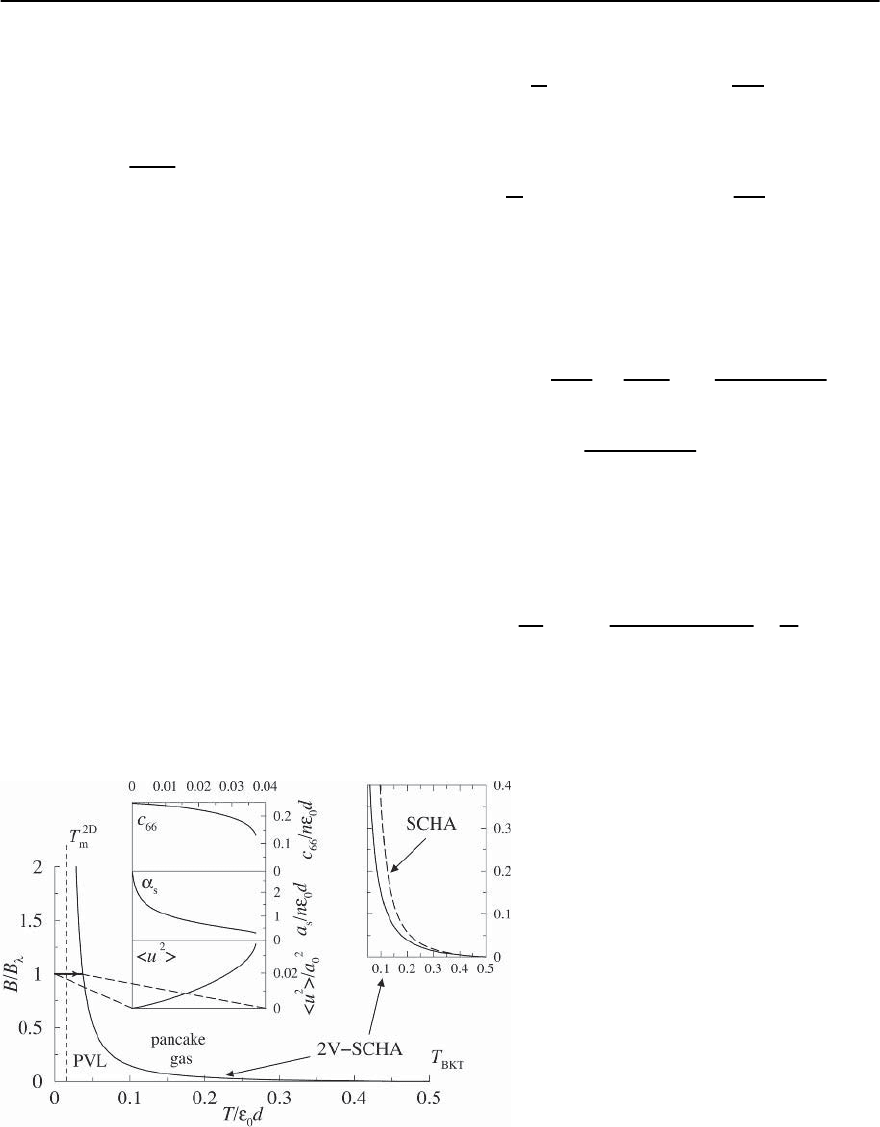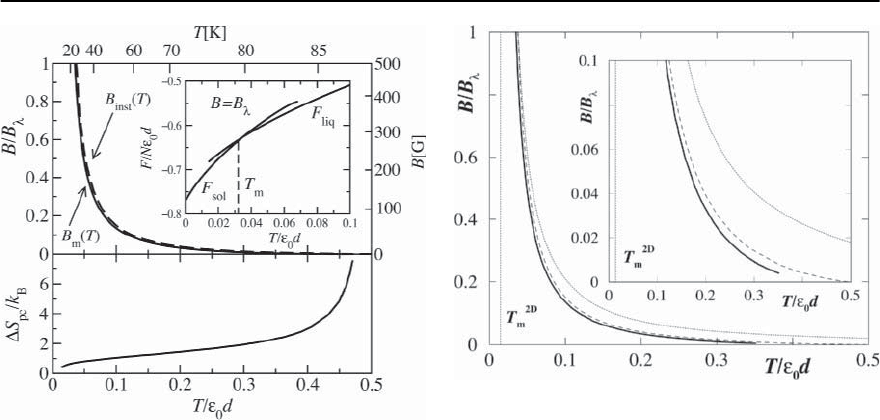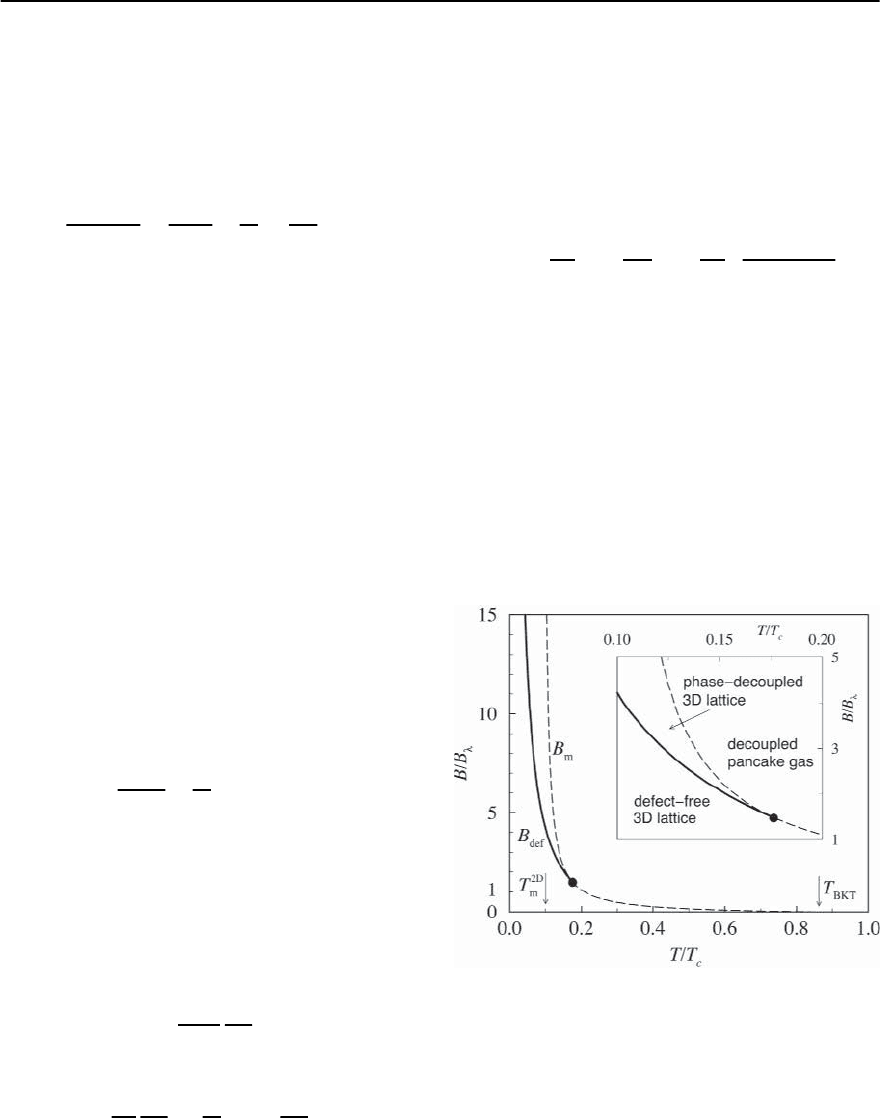Bennemann K.H., Ketterson J.B. Superconductivity: Volume 1: Conventional and Unconventional Superconductors; Volume 2: Novel Superconductors
Подождите немного. Документ загружается.


550 G. Blatter and V.B. Geshkenbein
wherewehaveassumedthata
0
< in the last equa-
tion. For a strong interlayer coupling the above con-
ditions require a
0
< < <
2
/ while a weak
coupling requires a
0
<
2
/ < < . The high-
field decoupling line then takes the form
B
J
dc
(T) ∼ B
"
0
d
T
2
,
B > B
×
≈ B
, < ,
B > B
×
≈ B
2
2
, < ,
(12.227)
with the usual definitions B
≡ ¥
0
/
2
and B
≡
¥
0
/
2
; note that with decreasing coupling strength
(increasing ) the crossover field B
×
first decreases
to approach B
at ≈ and then increases again as
increases further; since B > B
we are allowed to
approximate 1 + g ≈ 1 in this regime, as assumed in
the beginning.
For strong coupling < andintermediatefields
< a
0
<
2
/ the shear term ∝ K
4
and the electro-
magnetic energy ∝ K
2
lose the competition against
the Josephson couplingand the decoupling line takes
the form
B
J
dc
(T) ∼ B
"
0
d
T
,
B < B
, < or < . (12.228)
The same result is obtained in the low-field regime
2
/ < a
0
whenever the Josephson interaction out-
plays the electromagnetic coupling, whichis the case
whenever B drops below B
.This completes the anal-
ysis for the strong coupling situation.
For weak coupling ( < ) and intermediate
fields B
< B < B
×
(i.e.,
2
/ < a
0
< ) the phase
fluctuations are limited by the electromagnetic in-
teraction. The ∝ K
2
term in (12.226) is dominant
between the lower cutoff K
2
min
∼ (1 + g)/g
2
set
by the Josephson term and the upper cutoff deter-
mined by either the Brillouin zone boundary with
K
2
max
∼ 1/a
2
0
or by the shear term, in which case
K
2
max
∼ g/(1 + g)a
2
0
; correspondingly we find the
mean squared fluctuation
ı'
2
th
≈
T
4"
0
d
1+g
g
⎧
⎪
⎪
⎨
⎪
⎪
⎩
ln
B
×
B
, B
< B < B
×
,
ln
B
B
, B
< B < B
.
(12.229)
Comparing to more sophisticated calculations (cf.
Sect. 12.7.5 below) we find that the logarithm in
(12.229) is a peculiarity of the Lindemann analysis
andactually shouldbe replaced bya number ˛,hence
the low-field decoupling line assumes the form,
B
em
dc
(T) ≈
B
˛
"
0
d
T
ln
a
0
d
1−
˛T
4"
0
d
,
B
< B < B
×
, < , (12.230)
where the factor [1 − ˛T/4"
0
d]appearsasacon-
sequence of the renormalization of the superfluid
density through the factor g/(1 + g). Note that the
above weak-coupling result B
em
dc
does not depend on
the anisotropy parameter ".
The Lindemann criterion cannot tell us about the
underlying mechanism triggering the transition (in
fact, the Lindemann criterion assumes that the tran-
sition follows from a trivial increase in the fluctua-
tion amplitude). We will see later (cf. Sect. 12.7.5 be-
low) that in the low coupling limit " → 0thedecou-
pling transition assumes a topological character and
is triggered by the appearance of vortex loops,either
in the form of interstitial/vacancy pancake-vortex
pairs(these correspondto vortexloopsin planesper-
pendicular to the layers) or in the form of Josephson
vortex loops (i.e., loops parallel to the layers). The
defect transition is of the Kosterlitz–Thouless type
(cf. Sect. 12.7.5) and appears at B
em
dc
(T)asgivenby
(12.230) with ˛
def
= 8. The position of the loop tran-
sition has been determined via a self-consistent cal-
culation of the inter-layer coupling [73] and later via
a renormalization group approach [75],
B
em
dc
(T)=B
"
0
d
T
ln
a
0
d
,
B ≤ B
×
≈ B
2
2
, < . (12.231)
Again,thisresult followsthe Lindemann line (12.230)
if we set ˛
L
= 1 (the additional factor (1 − T/4"
0
d)in
(12.230) is due to the renormalization of the super-
fluid density which has not been taken into account

12 Vortex Matter 551
Fig. 12.13. Schematic low-field phase diagrams of layered superconductors with melting and decoupling lines. At high
fields/low temperatures the phase fluctuations triggering decoupling are limited by shear modes,while tilt modes are rele-
vant in the low-field/high-temperature region close to T
c
.Left:Forweakcoupling < the decoupling and melting lines
merge at intermediate temperatures with a joint transition at the electromagnetic melting/decoupling line B
em
m
= B
em
dc
.
With increasing coupling, T
em
→ 0 and the common melting/decoupling transition at B
em
m,dc
disappears as the transition
rises above the B
line for < (right). It is unclear whether the decoupling line in the vortex liquid corresponds to a
real phase transition or a mere crossover
in [73,75]). Since the defect transition involves an
eight times larger value of ˛, it preempts the Joseph-
son loop transition and the true decoupling is trig-
gered by the proliferation of free interstitials and va-
cancies in the small " limit.
Finally,let us combinethe above results for the de-
coupling transition with those obtained previously
for the melting transition and construct the corre-
sponding B–T phase diagram, cf. Fig. 12.13. Starting
from the small coupling limit " → 0, < ,we
notethat the low-fieldexpression (12.230)forthe de-
coupling line B
em
dc
coincides (up to a factor of order
unity) with the form of the electromagnetic melting
line B
em
m
, see (12.212), suggesting that the two tran-
sitions may join up within the temperature regime
T
2D
m
< T < T
em
[249]. Indeed, we will see below
in Sect. 12.7.5 that the melting line undercuts the
decoupling line and the two transitions merge into
a single one. As the temperature increases beyond
T
em
the Josephson interaction becomes relevant and
decoupling occurs in the liquid phase following B
J
dc
as given by the low-field result (12.228) above, see
Fig.12.13.Note that the interlayer phase fluctuations
are limited by tilt interactions in the low-fieldregime
where the decoupling occurs in the liquid phase, giv-
ing some justification to the application of (12.226)
in the liquid regime.On the other hand, the primary
expression (12.226) has been derived with the crys-
tal as a starting point (i.e., a well defined displace-
ment field u) and it remains unclear how much the
result of a second transition in the liquid can be
trusted. In fact, many suggestions have been made
regarding the existence of intermediate vortex liquid
phases [287,288] but a final conclusion has not been
reached(note that the various proposed intermediate
liquid phases involve layered and anisotropic super-
conductors as different starting points; e.g., the de-
coupling line (12.228) involves the layer separation d
and does not scale in the parameter T/").

552 G. Blatter and V.B. Geshkenbein
Increasing the layer coupling the branching point
at T
em
moves down in temperature and joins up
with the point where decoupling and melting merge
at low temperatures. The intermediate line B
em
m,dc
is
squeezed as the melting/decoupling transition rises
above the B
line. The phase diagram then simplifies
in the regime < with a simple cutting of the
melting and decoupling lines in the vicinity of the
point (T
2D
m
, B
) [71], see Fig. 12.13.
12.7.4 Vortex Lattice Melting in 2D Thin Films
An attractive scenario for the melting of 2D crystals
has been put forward by Nelson and Halperin [289]
who base their analysis on the unbinding of dislo-
cation pairs in the framework of a BKT transition.
This concept has later been applied to the 2D vor-
tex system in thin superconducting films [235,236]
(however, we remind that numerical simulations
[273–275] suggest 2D vortex lattice melting to be
first-order). The role of the logarithmically inter-
acting topological excitations is played by the edge
dislocations. Using a continuum description, the dis-
placement field of an edge dislocation with a Burgers
vector b =(b, 0) pointing along the x-axis is given
by [171,290]
u
dis
=
b
2
xy
R
2
+arctan
y
x
, −
x
2
R
2
(12.232)
and the energy associated with this defect is
e
dis
(R)=
d
2
R
R
0
d
2
R
c
66
∇
⊥
· u
dis
)
2
=
db
2
2
c
66
ln
R
R
0
. (12.233)
The lower cutoff R
0
is provided by the lattice constant
a
0
of the vortex lattice, whereas the upper cutoff R
is given either by the sample dimension L (→ self-
energy of the topological defect) or by the distance
R to the nearest dislocation with an opposite Burgers
vector (→ logarithmic interaction between two op-
positely“charged”topological excitations).Note that
the distortion (12.232) does not involve any com-
pression (∇·u
dis
= 0) but only shear forces, a conse-
quence of the incompressibility of the vortex lattice,
c
11
c
66
. For an elementary dislocation the Burgers
vector (the misfit-vector when encircling the dislo-
cation) is equal to a unit lattice vector and the energy
e
dis
(R) becomes
dis
(R)=
"
0
d
4
√
3
ln
R
a
0
, (12.234)
which isa factor4
√
3 ≈ 7 smaller than the corre-
sponding energy (12.195) for the vortex excitation
itself. The BKT-type dislocation-mediated melting
transition of the 2D vortex lattice then takes place
at a temperature [235,236]
T
2D
m
=
Aa
2
c
66
d
4
≈
A"
0
d
8
√
3
≈
"
0
d
70
T
BKT
. (12.235)
The numerical A ≈ 0.62 accounts for the renor-
malization of the shear modulus c
66
due to bound
dislocation pairs [269]. Vortex lattice melting in
thin Nb
3
Ge films following the dislocation-mediated
melting scenario has been observed by Berghuis,van
der Slot, and Kes [291].
The usual dislocation-mediated melting scenario
predicts a two-step transition [289,292]: The low-
temperature phase is characterized by quasi-long-
range translational order with a density–density cor-
relator
K
(R)
−K
(0)
th
=exp
−K
2
[u(R)−u(0)]
2
th
/4
(12.236)
∝ R
−
,
(T)=
TK
2
4c
66
d
, (12.237)
(here,
K
(R)=exp{iK
· [R + u(R)]} and we
have used [u(R)−u(0)]
2
th
∼ 2u
2
(R)
th
=
(T/c
66
d)ln(R/a
0
)) decaying algebraically with dis-
tance and producing algebraic Bragg peaks in the
structure factor,
S
K
(K) ∝|K − K
|
−2+
. (12.238)
In addition, the 2D crystal exhibits orientational
long-range order as quantified by the angle correla-
tor ¦
6
(R)¦
∗
6
(0)
th
, ¦
n
=exp[in (R)] with the bond-
angle field (R)=(@
x
u
y
− @
y
u
x
)/2. In the first step
of the melting process, dislocations unbind at T
2D
m
and destroy the translational quasi-long-range or-
der, while orientational long-range order transforms
into quasi-long-range order, ¦
6
(R)¦
∗
6
(0)
th
∝ R
−
6
with
6
=18T/K
A
,K
A
the Franck constant describ-
ing the stiffness of the bond-angle field (R). This

12 Vortex Matter 553
intermediate phase is the hexatic liquid. The melt-
ing is completed in a second BKT type transition (at
T
2D
h
= K
A
/72) where disclinations unbind(a dislo-
cation can be viewed as a tightly bound pair of discli-
nations),destroying the hexaticquasi-long-rangeor-
der in the bond-angle field.This“classic”topological
melting scenario is modified for high fugacities of
the dislocations, implying a large density of dislo-
cation pairs at the transition. The two continuous
transitions described above then collapse into a sin-
gle first-order transition [271–275] and the melting
transition is more conventional (a similar collapse is
familiar from the merging of the two critical fields
H
c
1
and H
c
2
into the first-order transition at H
c
as
= / decreases below the value 1/
√
2).
12.7.5 Electromagnetically Coupled Layered
Superconductors
The extreme case of a layered superconductor is
a stack of 2D superconducting films without any
Josephson coupling between the layers. This limit is
difficult to realize in a material as even a weak cou-
pling " ∼ 10
−3
already has an appreciable effect on
the phase diagram,cf.Fig.12.11; materialsapproach-
ing this limit are the layered BiSCCO compound and
the artificially grown multi-layer structures such as
the (Y/Pr)Ba
2
Cu
3
O
7−y
[188] and the Mo
x
Ge
1−x
/Ge
[189] systems. The interaction between pancake vor-
tices is of electromagnetic origin (see (12.126)): the
logarithmic intra-plane repulsion between pancake
vortices extends to infinity, V
0
(R)=−2"
0
ln(R/L)
(cf. (12.122), L denotes the system-size cutoff) and
the attractive inter-layer interaction is small by the
small factor d/ but long-ranged,extending over/d
layers (cf. (12.130)). The resulting line elasticity is
strongly dispersive,
"
l
≈
"
0
d
2
2
k
2
z
ln
1+
2
k
2
z
1+
2
K
2
BZ
. (12.239)
Note that short wavelength distortions with a
large k
z
∼ 1/d produce a potential energy
"
0
d ln(/d)(u/)
2
(this energy results from adding
the pairwise interaction energy (12.130) over /d
pairs),while long wavelength(k
z
< 1/)fluctuations
of a vortex line involve the elastic energy ∼ "
0
(k
z
u)
2
.
An individual stack of pancake vortices already
defines an interesting thermodynamic system: ther-
mal fluctuationsblur the vortex line and even trigger
its evaporation at high temperatures [65]: pulling a
pancake-vortex out of its stack costs the logarith-
mic energy 2"
0
d ln(u/) [65] and the usual energy-
entropy argument predicts a vortex-line evaporation
at T
evap
= T
BKT
= "
0
d(T
BKT
)/2. Note that with the
appearance of free vortices through vortex-pair un-
binding atT
BKT
the concept of a pancake vortex stack
looses its meaning; thisis consistentwith its evapora-
tion at T
evap
= T
BKT
.Thisstackevaporationisreadily
rederivedthrougha self-consistency argument [293];
the latter provides the basis for the self-consistent
substrate model [294] used below in the derivation
of the pancake-vortex lattice melting transition.
Each pancake vortex of the stack is subject to a
quadratic potential
V
s
(u)=
1
2
˛
s
u
2
(12.240)
produced by the other members of the stack. The pa-
rameter ˛
s
of this “substrate potential” is given by
the thermal average (cf. (12.148) where we have in-
troduced the elastic energy v
em
≈ ˛
s
/a
2
0
; here,we ac-
count for the thermal renormalization of this quan-
tity)
˛
s
=
n=0
@
2
u
x
0
V
em
int
(u
n
− u
0
, nd)
th
. (12.241)
Given the long-range nature of the pancake-vortex
interaction, we can ignore correlations in the
pancake-vortex fluctuations and hence
˛
s
(u
2
th
)=
−
n=0
d
2
K
(2)
2
K
2
x
V
em
int
(K, nd)e
−K
2
u
2
th
/2
≈
2"
0
d
d
2
K
(2)
2
exp(−K
2
u
2
th
/2)
1+
2
K
2
≈
"
0
d
u
2
th
⎧
⎪
⎪
⎪
⎨
⎪
⎪
⎪
⎩
u
2
th
2
2
ln
2
2
u
2
th
, u
2
th
2
2
,
1−
2
2
u
2
th
, 2
2
u
2
th
,
(12.242)

554 G. Blatter and V.B. Geshkenbein
with the pancake-vortex interaction energy
V
em
int
(K, nd)=¥
2
0
d
2
(dk
z
/8
2
) k
2
/[K
2
(1 +
2
k
2
)] exp(ik
z
nd) deriving from (12.126). On the
other hand, the equipartition theorem for a har-
monic potential tells us that u
2
th
=2T/˛
s
.The
two expressions for ˛
s
(u
2
th
) cut at a finite value
u
2
th
< ∞ if T < "
0
d/2; approaching T → "
0
d/2,
u
2
th
> 2
2
becomes large and we can find the
precise solution using the asymptotic expression in
(12.242). The mean square displacement
u
2
th
=
2
2
1−2T/"
0
d
(12.243)
diverges at T
BKT
= "
0
d(T
BKT
)/2 and the pancake vor-
tex stack evaporates.
The discussion above and in Sect. 12.7.4 provides
us with two important results [294]: First, we know
the position of the melting line for the pancake-
vortex lattice in the two limits of high and low fields
(ignoring reentrance in the latter case). For high
fields B ¥
0
/
2
= B
thein-planerepulsionis
the dominant interaction between pancake vortices
and the melting process exhibits a 2D character: the
lattice melts as the temperature is increased beyond
T
2D
m
≈ "
0
d/70.In BiSCCO the penetration depth is of
order (0) ≈ 2000 Å and d ≈ 15 Å, "
0
d ≈ 750 K, and
the high-field limit of the melting line approaches
T
2D
m
≈ 11 K. At low fields, the electromagnetic in-
teraction between pancake vortices in different lay-
ers is dominant. In the limit B → 0 we can ignore
the interaction between pancake-vortex stacks and
these stacks melt or evaporate at T
BKT
(note that
the true melting line will reenter before reaching the
stack evaporation temperature); for BiSCCO we have
T
BKT
≈ 0.9 T
c
(note, however, that Josephson cou-
pling cannot be ignored in BiSCCO, hence one has
to expect that the low-field melting line is pushed
closer to T
c
). Second, we have learnt how to use a
self-consistent substrate model for an accurate de-
scription of the evaporation transition of an individ-
ual pancake-vortex stack — below we will generalize
this idea to describe the melting (evaporation) of the
pancake-vortex lattice.
Pancake-Vort ex Lattice Melting
Knowing the position of the melting line in the two
limits of high and low fields (up to reentrance), the
question is how to obtain the line in between. Here,
we can make use of the above analysis: The self-
consistent substrate model accurately describes the
melting/evaporation of a single pancake-vortex stack
(a self-consistent harmonic approximation has been
used in the analysis of the 2D XY-model [295]). The
idea then is to extend this analysis to the 3D pancake-
vortex system at finite fields.Let us choose one of the
layers (say n = 0) as our reference, then the pancake
vorticesin the otherlayersformstackswhichprovide
a periodic substrate potential in which the pancake
vortices of our reference layer are trapped. Without
this substrate potential, our 2D pancake-vortex sys-
tem would melt at T
2D
m
. The substrate potential sta-
bilizes the crystal and pushes the melting tempera-
ture to higher values — the 3D crystal turns unsta-
ble when the substrate potential collapses. Given the
long-range nature of the pancake-vortex interaction
one expects that the mean-field type analysis as for-
mulated through the self-consistent substrate model
provides accurateresults for the stabilityrange of the
vortex lattice.Note thatwe ignore herethe reentrance
of the melting line at low magnetic fields.
Theaccuratedeterminationofthestabilityregion
of the pancake-vortex crystal requiresnumerical cal-
culation of the thermal renormalization of the shear
modulus c
66
(T) and the substratepotential ˛
s
(T): the
simplest analysis is based on a self-consistent har-
monic approximation (SCHA) with a Hamiltonian
H
h
=
1
2
BZ
d
2
K
(2)
2
u
0˛
(K) ¥
˛ˇ
(K) u
0ˇ
(−K) (12.244)
and requires calculation of the thermally averaged
elastic matrix
¥
˛ˇ
(K, u
2
th
)=
1
a
2
0
R
1−e
iKR
(12.245)
×@
˛
@
ˇ
V
em
int
(R
, 0)
th
+
n=0
@
˛
@
ˇ
V
em
int
(R
, nd)
th

12 Vortex Matter 555
(here, the first term corresponds to the expression
(12.69) while the second accounts for the substrate
potential (12.241)) together with the mean squared
displacement amplitude
u
2
th
= T
BZ
d
2
K
(2)
2
[¥
−1
]
˛˛
(K, u
2
th
) . (12.246)
After Fourier transformation the thermal average in
(12.246) can be expressed through the Debye–Waller
factor exp(−K
2
u
2
th
/2); the 3D crystal becomes un-
stable when this system no longer exhibits a solution
for u
2
th
. However, the proper inclusion of anhar-
monic effects require a more accurate analysis going
beyond the SCHA scheme, e.g., the two-vertex SCHA
which includescubic anharmonicities[294,296].The
numerical results [294] exhibit a smooth decrease of
c
66
(T)and˛
s
(T) with increasing temperature up to
the instability field B
inst
(T), with reduction factors
∼ 0.5and∼ 0.1 near the collapse, cf. Fig. 12.14.
In order to find the melting line we have to go
one step further: for a first-order transition the low-
temperature phase can be overheated to the upper
spinodal and the instability temperature T
inst
only
provides an upper estimate for the melting temper-
ature T
m
< T
inst
. The determination of the melting
temperature requires calculation of the free energies
(here at fixed B) of the solid and liquid phases; their
intersection defines T
m
. The free energy of the solid
can be calculated within a variational scheme: Given
the Hamiltonian H = H
2D
+ H
s
with
H
2D
=
N
2
R
=0
V
em
int
(R
, 0) −
d
2
R
a
2
0
V
em
int
(R, 0)
(12.247)
and
H
s
=
N
2
R
,n=0
V
em
int
(R
, nd)+
d
2
R
a
2
0
V
em
int
(R, 0)
,
(12.248)
the variational free energy F
h
+ H − H
h
h
is
minimized through the SCHA Hamiltonian H
h
,cf.
(12.244), and involves the harmonic free energy of
2D fluctuations
F
h
=−
NTa
2
0
2
BZ
d
2
K
(2)
2
ln
(/e)T/a
4
0
c
66
K
2
+ ˛
s
/a
2
0
+ln
(/e)T/a
4
0
c
11
K
2
+ ˛
s
/a
2
0
,
the ground state energy H
2D
− H
h
2D
h
=−0.749N"
0
d
of a 2D lattice of N log-interacting particles [297],
and the substrate energy
H
s
− H
h
s
h
=
−N
2
a
2
0
"
0
d
=0
exp[−K
2
u
2
th
/2]
K
2
(1 +
2
K
2
)
+
˛
s
2
u
2
th
.
The free energy F
liq
of the pancake-vortex liquid is
calculated from the internal energy U ( )ofa2D
log-interacting system via integration, F
liq
( )=
Fig. 12.14. Instability line B
inst
for the pancake-
vortex lattice (PVL) in the B–T plane calcu-
lated with the two-vertex-SCHA. The line goes
asymptotically to T
2D
m
at high fields and ends at
T
BKT
at zero field. The left inset shows the two-
vertex-SCHA results for the shear modulus c
66
,
the substrate strength ˛
s
, and the fluctuation
width u
2
th
with increasing temperature at the
field B = B
.Theright inset is a zoom of the in-
stability line at low fields, and shows the result
(dashed line) of the simple SCHA scheme

556 G. Blatter and V.B. Geshkenbein
Fig. 12.15. Instability (dashed)andmelting(solid )lines
in an electromagnetically coupled layered superconduc-
tor. The melting line derives from cutting the free en-
ergies of the solid and liquid phases, see inset (data for
B = B
). The lower graph gives the entropy jump per
pancake-vortex S
pc
. Also shown are the real temperature
and field scales assuming (T)=(0)/[1 − (T/T
c0
)
2
]
1/2
,
with (0) ≈ 2000 Å,d ≈ 15 Å, and T
c0
≈ 100 K
0
F
liq
(
0
)+
0
d
U(
), with the internal energy (we
remind that =2"
0
d/T)
U( ) ≈ N"
0
d [−0.751 + 0.880
−0.74
−0.209
−1.7
]
known from numerical simulations [269] and the in-
tegration constant deriving from an exact solution at
0
=2whereF
liq
(2) = 0.081 N"
0
d [297] (we assume
that the 2D liquids in neighboring layers have lost
all correlations). The result of this analysis is shown
in Fig. 12.15 and produces a melting line B
m
(T)very
close to the instability line B
inst
(T)(similarresults
have been found for the stability region of the mag-
netically coupled pancake-vortex lattice within the
framework of density functional theory [298,299]).
The intersection of this melting line with the low-
field reentrant line (12.216) is located at a field value
B/B
≈ 0.005 and a temperature T
x
/"
0
d ≈ 0.35 or
1−T
x
/T
c
≈ 0.15 (we have used "
00
d/T
c
≈ 15; note
that the expression for B
mr
/B
involves the param-
eter /d when expressed through the combination
Fig. 12.16. Comparison of melting (solid) and instability
(dashed) lines obtained within the self-consistent substrate
model with the electromagnetic melting line (dotted)from
a Lindemann analysis with c
L
=0.065. The discrepancy
between these results at high temperatures is traced back
to the thermal renormalization of elastic coefficients, ac-
counted for in the substrate model but not in the Linde-
mann analysis. The true melting line is expected to reenter
near T
x
/"
0
d ≈ 0.35 where our line is terminated
T/"
0
d and hence the point of reentrance is not uni-
versal; in BiSCCO, the Josephson coupling cannot be
ignored and the point of reentrance is pushed close
to T
c
).
The jump in the slope S =−@
T
F gives the latent
heat TS = U; at high fields the entropy jump
per pancake-vortex takes a value S
pc
≈ 0.4 k
B
,
consistent with experiments [42] and simple esti-
mates [300]. The increase of the entropy jump with
temperature follows naturally from the analysis of
the magnetization and entropy jumps in layered su-
perconductors, see (12.268) in Sect. 12.7.6 below.
In Fig. 12.16 we compare the results obtained
within the substrate model with those of the Linde-
mann analysis presentedin Sect.12.7.2above.Choos-
ing a Lindemann number c
L
=0.065 the results agree
well at low temperatures and high fields,close to the
2D-melting limit (note that a similarly small Lin-
demann number has been found in the discussion
of vortex lattice melting in 2D films, cf. (12.209)).
However, for high temperatures T/"
0
d → 0.5the
Lindemann result largely overshoots the result from

12 Vortex Matter 557
the substrate model (also, the Lindemann result in-
volves the dimensionless temperature T/T
c
while
the substrate model scales in T/T
BKT
). We can trace
back this discrepancy to the thermal renormaliza-
tion of the elastic constants at high temperatures,
whichis accounted for within the substratemodel,cf.
Fig.12.14,butnot in the Lindemann analysis.Replac-
ing the tilt modulus c
44
(k) ≈ "
0
/2a
2
0
2
k
2
z
ˇ in (12.208)
by the renormalized coefficient ("
0
/a
2
0
u
2
th
k
2
z
)(1 −
2
2
/u
2
th
) (cf. 12.242) we can properly account for
the thermal softening of the pancake vortex stacks
and the renormalized Lindemann result comes to lie
close to the instability and melting lines of the sub-
strate model.
Defect–Unbinding Transition
The pancake-vortex crystal in an electromagnetically
coupled superconductor exhibits a second phase
transition besides the melting/sublimation transi-
tion discussed above. This second transition is due
to the unbinding of interstitial-vacancy pairs (of the
Kosterlitz–Thouless type) and transforms the low-
temperature, low-field crystal into a 3D defected
crystal at high temperatures or fields [76].The basis
for this transition is given by an interesting screen-
ing effect which exactly (partially) compensates the
logarithmic defect energy in a 2D vortex crystal (3D
pancake-vortex crystal) [301,302].
Consider arigid3Dpancake-vortexlatticein a lay-
ered superconductor and move one pancake-vortex
by the distance
¯
R within the same layer to produce
an interstitial-vacancy defect pair.The excitation en-
ergy associated with this manipulation contains a
self, an interaction, and a core-energy part and reads
E
i,v
(
¯
R, L)=2"
0
d
ln
L
a
0
−ln
L
¯
R
+(
i
+
v
)"
0
d .
(12.249)
The numericals
i,v
quantify the core energies of the
interstitial and the vacancy-defect and are of order
0.15–0.2 [303,304] and L denotes the system size.
Next, we let the lattice relax and determine the
screened self-energy of the defect — the interaction
between the defects is screened in the same manner.
We first ignore the electromagnetic coupling to the
pancake vortices in the other layers and take them
into account in a second step later. The interaction
energy of the pancake-vortex configuration reads
E
int
=
1
2
,
V
pc
(R
− R
) (12.250)
=
1
2
BZ
d
2
K
(2)
2
n(K)V
pc
(K) n(−K)
(V
pc
(R)=−2"
0
d ln(R/a
0
) is the pancake-vortex in-
teraction energy, see
(12.122), and n(K)=
e
iK·R
denotes the Fourier
transform of the pancake-vortex density), from
which one can derive the dispersive compression
modulus
c
11
(K)=n
2
V
pc
(K)=
4"
0
d
a
4
0
K
2
, (12.251)
with n = B/¥
0
the vortex density. The change in en-
ergy due to the presence of the defect can be written
in the form
ıE
int
=
BZ
d
2
K
(2)
2
(12.252)
×
c
11
2
|K ·u(K)|
2
+in[K · u(K)] V
pc
(K)
.
While the first term in (12.253) describes the elastic
energy of the relaxed lattice, the second term origi-
nates from the forcethe interstitial exerts on the pan-
cake vortices,E
source
=
V
pc
(R
−u
) (we place the
interstitial at the origin). Minimizing (12.253) with
respect to u we obtain the distortion
u(K)=−
inKV
pc
(K)
c
11
(K)K
2
=−
i
n
K
K
2
; (12.253)
the displacement u(R)=R/2nR
2
removes ex-
actly one pancake-vortex from the neighborhood of
the interstitial and thus produces perfect screening
[301]. The log-divergent self-energy in (12.249) then
is compensated by the gain in elastic energy under
the relaxation of the lattice: inserting the solution
(12.253) back into (12.253), we obtain
ıE
int
=−
1
2
BZ
d
2
K
(2)
2
V
pc
(K)=−"
0
d ln
L
a
0
.
(12.254)

558 G. Blatter and V.B. Geshkenbein
This perfect screening is spoiled by the interaction of
the pancakevorticesin the layer (n = 0)withthose in
the other layers (n = 0); adding the substrate poten-
tial (12.240) with ˛
s
=("
0
d/
2
)ln(a
0
/d),cf. (12.148)
where v
em
≈ ˛
s
/a
2
0
,to the energy (12.253) and mini-
mizing, the displacement field (12.253) is reduced by
the factor 1 + g with [301]
g =
n˛
s
c
11
(K)K
2
=
a
2
0
4
2
ln
a
0
d
≈
H
c1
B
. (12.255)
The screening charge is reduced to the fraction
1/(1 + g) and the divergent self-energy in (12.249)
is only partially canceled by the lattice relaxation;
inserting u(K) back into the expression (12.253)
for the change in the interaction energy we obtain
ıE
int
=−"
0
d ln(L/a
0
)/(1 + g). The relaxation of the
pancake-vortex lattice then reduces the self-energy
in (12.249) by the factor g/(1 + g). At large fields,
B > H
c
1
,where thevortex–vortex interaction is dom-
inated by intraplanar forces, we have g < 1 and a
large downwardrenormalization of the energy of the
defects.When g > 1atsmallfieldsB < H
c
1
,theinter-
action between pancake vortices is dominated by the
interlayer forces and the effect of screening is small.
The above analysis extends trivially to the case
of a pancake-vortex vacancy as well as to the in-
teraction between the defects. The energy for an
interstitial-vacancy pancake-vortex pair of extent R
placed into one plane of a decoupled layered su-
perconductor then involves the screened self and
interaction-energies
E
sc
i,v
(
¯
R, L)=
2g"
0
d
1+g
ln
¯
R
a
0
+(
i
+
v
)"
0
d . (12.256)
The result (12.256) with its logarithmic interaction
between interstitial-vacancy defect pairs immedi-
ately implies a Berezinskii–Kosterlitz–Thouless tran-
sition [257] where these defects unpair, producing a
crystal with free defects. The field dependent screen-
ing of the interaction pushes this defect-unbinding
transition to low temperatures,
T
def
(B)=
g
1+g
"
0
d
2
, (12.257)
and solving for B we obtain the defect-unbinding line
B
def
(T)=
B
4
"
0
d
2T
ln
a
0
d
1−
2T
"
0
d
. (12.258)
Thermal fluctuations soften the substrate poten-
tial and modify the result (12.258): Using (12.242)
with (12.243)we obtain ˛
s
(T)=(T/
2
)(1 − 2T/"
0
d).
The defect-unbindingline then has to be determined
from (12.257) using the renormalized suppression
factor g(T)=(a
2
0
/8
2
)(2T/"
0
d)(1 − 2T/"
0
d) for
the superfluid density and we obtain the final result
near T
BKT
B
r
def
(T)=
B
8
1−
2T
"
0
d
2
=
B
8
1−T/T
BKT
1−T/T
c
2
.
(12.259)
Here,wehaveusedthat(1−2T/"
0
d) ≈ [(1 −
T/T
BKT
)/(1 − T/T
c
)] close to T
c
. The last factor in
(12.259) replaces the Ginzburg–Landau temperature
dependence in
−2
∝ 1−T/T
c
by the temperature
factor1−T/T
BKT
accounting for 2D fluctuationsand
pushes the defect-unbinding line to zero at T
BKT
.Note
that the second factor(1−T/T
c
)
−1
≈ (1−T
BKT
/T
c
)
−1
enhances the prefactor in (12.259).
The position of the defect line B
def
(T)shouldbe
compared with the melting line as found in the pre-
vious paragraph. The result of such a comparison
is shown in Fig. 12.17, where we plot the full melt-
Fig. 12.17. Phase diagram for an electromagnetically cou-
pled layered superconductor. The solid line marks the
defect-unbinding transition B
def
,whichtransformsinto
the decoupling transition B
dec
in the case of a finite weak
Josephson coupling with " < d/.Thedashed line shows
themeltinglineB
m
calculated within a self-consistent anal-
ysis (with parameters (0) ≈2000 Å,d ≈15Å,T
c
≈100 K)

12 Vortex Matter 559
ing line B
m
(T) (dashed) together with the defect-
unbinding line B
def
(T) (solid); we find that the melt-
ing line undercuts the defect-unbinding line, leav-
ing only one (sublimation) transition B
m
(T)athigh
temperatures,see also Fig. 12.13. Note that the renor-
malized defect line B
r
def
(T) vanishes rapidly as T ap-
proaches T
BKT
; in principle this allows for a reap-
pearance of the defect line below the melting line as
T → T
BKT
. The analysis of the structure of the phase
diagram near T
BKT
then requires precise knowledge
of the shape of the defect line and of the melting line
including its reentrance; in fact,the reentrance of the
melting line may well preempt the reappearance of
the defect line at high temperatures.At low tempera-
tures, B
def
(T) remains below the melting line, allow-
ing for two transitions separating a defect-free solid,
a defected solid, and a pancake-vortex gas.
The low-temperature defect transition at B
def
≈
B
("
0
d/8T)ln(a
0
/d) in electromagnetically cou-
pled systems should be compared with the decou-
pling transition B
em
dc
≈ B
("
0
d/T)ln(a
0
/d) (cf.
(12.231)) in weakly coupled layered superconduc-
tors. Indeed, with a small but finite Josephson cou-
pling present, the lattice defects trigger the decou-
pling of the layers and the defect-unbinding line
B
def
(T) turns into a decoupling line B
def
dc
(T). For
fields above B
def
dc
(T) the system develops a finite c-
axis resistivity with
c
proportional to the density
of free mobile defects n
d
, see [101]. Close to the un-
binding transition, free defects appear in the solid
with a density n
d
∼ a
−2
0
exp[−2
b/(T/T
def
−1)]
(with b a non-universal constant). At higher tem-
peratures the core energy E
core
= "
0
d determines
n
d
a
2
0
∼ exp(−E
core
/T). Such a topological decou-
pling transition based on a quartet-unbinding has
first been proposed by Feigel’man et al. [64] (see
also [74] for a similar supersolid transition).
Whereas the defect-unbinding transition B
def
is the finite-field generalization of the zero-field
vortex-unbinding transition at T
BKT
,thedecoupling
transition B
em
dc
[73,75] is the finite-field generaliza-
tion of Friedel’s loop transition at T
loop
=8T
BKT
,cf.
Sect. 12.7.1. This pair of transitions is easily derived
from the Lawrence–Doniach model (12.97): for zero
coupling " the individual layer develops a vortex-
unbinding transition at T
BKT
. On the other hand,
restricting ourselves to a pair of (coupled, " > 0)
layers and going over to sum (¥
+
=(¥
1
+ ¥
2
)/2)
and difference (¥
−
= ¥
2
− ¥
1
) phase variables we ar-
rive at the Sine–Gordon model with a “roughening”
temperature at 8T
BKT
, independent of the coupling
". Obviously,the zero-field vortex-unbinding transi-
tion at T
BKT
preempts the zero-field loop transition
in the limit of small interlayer coupling. Increasing
the coupling " the transition is shifted upward, cf.
(12.204). The same pair of transitions can be contin-
ued to finitemagnetic fields.The presenceof pancake
vortices then is easily accounted for via the reno-
malization of the superfluid density, cf. (12.97) and
(12.154), and we obtain the finite-field versions of
the two zero-field transitions where vortices/defects
unbind and where Josephson loops are created spon-
taneously. Again, in the limit of small coupling the
vortex-induced decoupling transition B
def
dc
is eight
times lower than the “loop” transition at B
em
dc
,cf.
(12.231).At finite coupling the true transition is ex-
pected at a value between B
def
dc
and B
em
dc
:comparing
the Josephson energy
2
def
E
J
with E
J
= "
0
d/
2
,see
(12.97), within the coherence area
2
def
≈ n
−1
d
with
the temperature we estimate the upward shift of the
decoupling transition due to the Josephson interac-
tion
T
J
dc
(B) ≈
E
core
ln
[
(E
core
/"
0
d)(B/B
)
]
. (12.260)
While the result (12.258) is valid at low fields, the
steep upward shift described by (12.260) becomes
effective when g ≈ H
c
1
/B < / ln(d/"), with
= E
core
/"
0
d the numerical quantifying the core
energy of the defects (see [303,304] where numeri-
cal values ≈ 0.15 − 0.2 are reported). The quan-
titative condition for the applicability of the result
(12.258) thus depends both on the anisotropy pa-
rameter " as well as on the defect core-energy E
core
.
At higher fields B > (8/)ln(d/")H
c
1
the decou-
pling line crosses over into the “loop” transition at
B
em
dc
as given by (12.231)[73,75];an accurate descrip-
tion of the crossover between the defect and “loop”-
transitions requires a generalization of the analysis
in [82] to finite fields.
The pair of transitions discussed above is not
unique to the vortex system discussed here — it ap-
pears in the context of the XY-model (with coupling
